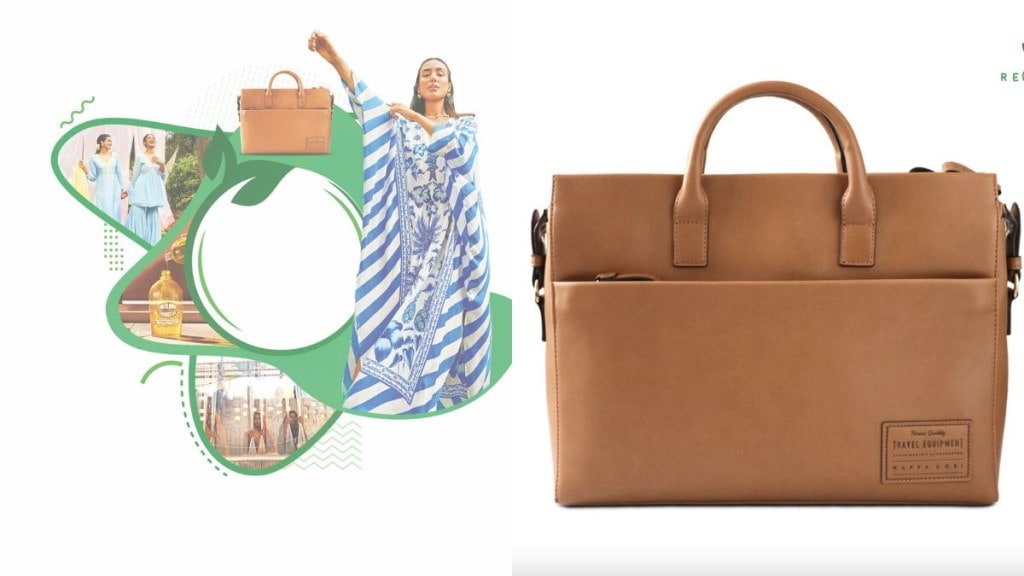For Anjali Patel Mehta, sustainability is more than just a fleeting trend—it is a long-term commitment. So when the Mumbai-based entrepreneur decided to launch Verandah, a conscious-luxury resort wear brand, in 2015, she started to source discarded denim and post-production waste from her husband’s denim factory. The idea was to create an environmentally and socially responsible luxury label inspired by sights, smells, and contours of the land.
“I was using textile fibres like Tencel and Denburg when people were not even familiar with the word ‘sustainable luxury’ in the fashion world,” she adds. But sustainability doesn’t come cheap. In ensuring that every product has the least impact on the environment, there are several factors that come into play that eventually decide the pricing. The assessment of green-certified luxury is a long-drawn process covering environmental and social governance, innovation and data backed assessment, and this process and development command premium pricing, feels Mehta.
“Our sustainable measures include labour policies, fair trade, sustainable sourcing, waste management, energy usage, and CSR initiatives, such as the Baagh Pari project, an initiative to encourage the education of Moghiya tribal girls in Ranthambore. In addition, we have data records fabric testing certificates for biodegradability and proof of sustainable yarn usage, supplier, and vendor sustainability carbon-neutral shipping offsets, monthly water, energy, and municipal garbage collection bills,” adds Mehta, who retails in exclusive boutiques in Palm Beach in Florida, Paris and New York apart from her flagship stores in Goa and Mumbai.
So does pricing affect the buying behaviour of consumers? “India needs to understand why sustainable luxury is high-priced. Green-certified luxury commands premium pricing and is not meant for the masses. The price tag surprises many Indian clients and not international buyers, who like to understand the process or are aware about product pricing and sourcing,” adds Mehta, who uses regenerated and biodegradable yarns (Ecovero, Bemberg, and Lenzing) as well as Global Organic Textile Standard (GOTS)-certified organic cotton to support farmers and fair-trade practices.
As per Gautam Sinha, creative director and founder of Nappa Dori, a certified and authenticated product tends to fetch a higher price as it undergoes a thorough certification process, validates the product quality, allowing sellers to justify charging more. “But pricing also hinges on other factors. For instance, a vegan leather product sold in Europe could be more expensive than in India due to market dynamics and varying purchasing power,” adds Sinha.
Nappa Dori has an eco-conscious collection crafted with apple leather, a sustainable alternative to traditional leather derived from apple pomace.
In the luxury segment, sustainability is well-received among consumers showing a strong willingness to accept a reasonable incremental price provided performance remains uncompromised. “Certified products are often priced higher due to the costs associated with certifications and accreditations. But the price difference between green certified and non-certified doesn’t significantly impact consumer buying behaviour, provided the premium for certified goods remains reasonable,” offers Avinash Mane, senior commercial director of textile business at Lenzing fibres, AMEA & NEA, a chemical company that manufactures and markets cellulose and fibres for the textile and nonwovens industry.
While such sustainable practices involve meticulous planning, unfortunately, we are losing touch with what has been rooted in Indian culture for generations, feels Mehta of Verandah. “Today, there is a need for awareness as a cross-section of consumers is now paying attention to the finer details of creating a brand,” offers Mehta, whose collections start at Rs 10,000 onwards.
As India’s first brand to bag the ‘Butterfly Mark’ certification for sustainable practices, Verandah joins the likes of global luxury brands like Louis Vuitton, Christian Dior, and Tom Ford Beauty for ‘contributing to the future of the planet’. Butterfly Mark is an initiative by UK-based independent organisation Positive Luxury that is awarded to brands meeting higher standards for people and nature.
Luxury brands leading the sustainability quotient emphasise on artisanal and ethical standards in sourcing, efficient use of material, low-impact manufacturing, assembly, and distribution, and hence the premium pricing. “There hasn’t been significant research, especially in Asia on this topic. While this trend holds true in Scandinavian countries, it may take a few years to gain traction in India or across Asia. Luxury brands have a considerable distance to cover before alternative materials can command prices comparable to genuine leather goods. It’s also undeniable that luxury remains a highly desirable segment, and consumers are increasingly willing to pay more for superior quality and the overarching ethos it represents,” says Sinha of Nappa Dori.
Buying behaviour
As per Megha Pitti, founder of the eponymous ensemble label, there are several factors when consumers are willing to pay premium. “Luxury-certified brands are associated with superior quality and craftsmanship, high-quality materials and production processes. They offer exclusivity, heritage and compelling storytelling. More consumers view these products as investments rather than purchases with the expectation that they will stand the test of time in terms of both quality and style,” says Pitti, whose brand offers a mix of haute bohemian sensibilities, combining maximalism and kitsch, with products priced between Rs 8,000 and Rs 36,000.
Another aspect is the influence of social media, which sees higher resale value. “Conscious consumers are influenced by social media and peers, they are willing to pay a premium for social status and investment value,” says Avani Karan Chandan, co-founder of fashion clothing label House of Ara, which has products in Kantha needlework in the range of Rs 3,000 to Rs 17,000 .
Luxury-certified pricing is a phenomenon steeped in psychological, cultural, and social intricacies. “In a world where counterfeit products and fast fashion proliferate, this sort of certification offers peace and a guarantee of genuine luxury,” says Shubh Goyal, creative director of Fierce London, a UK-based luxury streetwear brand that offers products priced from £140-£1,100.
Moreover, luxury-certified brands provide consumers with an elevated sense of status and identity. “Owning such items becomes a symbol of success and refined taste. The psychological gratification derived from these possessions is significant; it taps into the human desire for recognition and social validation. This desire is pronounced among young, affluent demographics who seek to assert their individuality and social standing through their sartorial choices,” adds Goyal.
Clearly, there is awareness towards green, particularly prominent among young buyers, in the age group of 20-45 years. “If price can influence buying behaviour to some extent, those who prioritise sustainability are willing to pay the extra cost, viewing it as an investment in environmental conservation and ethical practices.
Green products are perceived as safer, healthier alternatives, while there is a noticeable awareness in sustainability among young buyers aged 20-45 years,” says Simi Dewan, country head, L’Occitane India, who feels this demographic prioritise brands that align with their values.
“Factors like social media, education, and access to information play significant roles in shaping their attitudes and purchasing decisions,” adds Dewan. L’Occitane India supports local development projects and sourcing from small, integrated networks with traceability, and certifications like Fair Trade and Eco certifications for certain ingredients to validate brand commitment.
Conscious consumerism
“The certified luxury buying trend is a positive development from the conscious consumers. The trust and transparency have been crucial in retaining buyers who value sustainability,” says Angelique Dhama, president of Obeetee Retail, a leading producer and exporter of handmade carpets in India. The brand’s production process, from sourcing eco-friendly materials to employing traditional and low-impact weaving techniques, assures consumers purchase handwoven carpets that use natural hand-spun wool unwoven hand-spun linen, BCI cotton, organic cotton, recycled cotton, hemp, and jute.
Meanwhile, brands like Stella McCartney, Anita Dongre, Gucci, and Bottega Venetta have also raised the sustainability bar with their certified luxury offerings.
Stella McCartney, for instance, uses alternative materials like Mylo, a mushroom-based substitute for traditional leather. Similarly, Anita Dongre’s Grassroot—an exclusive label introduced by the designer—features ethically produced sustainable clothing, promotes intricate threadwork, hand-embroidery, dyeing techniques as well as use of biodegradable and compostable fibres like Bemberg and Tencel, along with cotton sourced from the Better Cotton Initiative, a leading global sustainability initiative for cotton.
The list goes on. Gucci has pioneered the use of ECONYL, a fabric crafted from recycled consumer waste, discarded carpets, and ghost fishnets. Designer Ritu Kumar, for her autumn/winter 2020/2021 collection, collaborated with the sustainable fibre brand Lenzing Ecovero. Bottega Venetta has introduced a line of eco-friendly handbags, driven by the goal of reducing carbon emissions. The brand uses Naoron paper, crafted from mulberry tree bark, and Japanese washi paper for this collection.
The luxury industry is also advancing toward a circular economy model, a trend supported by AI and technology. Digital Product Passports (DPP) and Digital IDs are being deployed to document a product’s sustainability and circularity throughout its entire lifecycle, from design to end of life. The benefits of these initiatives are manifold, including increased consumer trust, improved brand sentiment, reduced risk of greenwashing, comprehensive product tracking, a decrease in the number of goods in circulation, and the exploration of potential new business models.
The European Union (EU), while working on the DPP initiative, a digital identifier that encapsulates a product’s entire journey from conception to disposal, mandates that every textile product sold within its borders must possess such a passport, accessible via a scannable QR code, NFC (Near Field Communication) chip, or tag by 2027.
The Aura Blockchain Consortium, a non-profit organisation, offers blockchain agnostic solutions exclusively to luxury brands like LVMH, OTB, Prada Group and Cartier for enhanced customer experience. “Tagging a product and enabling digital storytelling can be a conversation starter for the sales assistants in our boutiques,” says Lorenzo Bertelli, head of marketing and CSR at the Prada Group in a press statement. “It increases the conversion rates and ensures that the customer verifies the ownership of their product, creating a new channel for direct engagement that never existed before.”
In a DPP pilot, Prada found that products augmented by digital storytelling triggered a higher average spend in customers under 35 years old.
“Digital Product Passports will play an important role in adding another layer of trust, authenticity and sustainability, which are very important values to the customers. DPP can help us deliver a truly seamless customer experience, allowing us to enhance the relationship with our communities and directly share the story behind our timeless products,” says Carlo Alberto Beretta, general brand manager of Tod’s, an Italian fashion house that specialises in footwear, apparel, and related accessories.
COST OF FASHION
$146.3 bn Projected size of India’s fashion apparel industry by 2032
2nd Fashion industry ranked just below oil industry among world’s largest polluters
10% of total global carbon emissions come from fashion production
93 bn cubic metres of water used by production of textiles annually
5% of total waste worldwide stems from textile industry
20% of clothing recycled or reused; rest end up as huge amounts of waste
$172 mn worth of garments expected to be discarded each year, many of them after being worn only once
34.8% of microplastics found in oceans come from textile and clothing industry; majority made of polyester, polyethylene, acrylic, elastane








